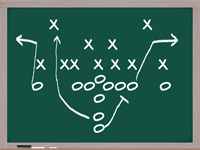
Why do the new standards place so much emphasis on multi-paragraph writing? Because multi-paragraph writing helps students develop fluency in building arguments, explaining ideas, and telling stories—thinking skills they need for college and career.
Yet we often struggle to get more than a paragraph at a time out of our students. A recent study found that fewer than 1 in 10 writing assignments in urban middle schools produce multi-paragraph responses, and just 16 percent include evidence drawn from sources. The middle school assessments for the Common Core require this rigor, but how can we create a writing program that fosters this kind of writing and thinking?
Step 1: Make Time for Writing

The first barrier to rigor in writing instruction is time. Multi-paragraph writing requires time. Students can't write at length and think deeply if they write for only five minutes at a time. Just as we have traditionally carved out time for reading, we must also do so for writing.
Writing is like weight lifting. The only way to build writing muscles is to do it routinely and purposefully. The very act of crafting words develops thinking skills. And just as every weight lifter is consciously working to get stronger, every writer should be consciously writing to get smarter.
Perhaps that sounds flippant, but as Carol Dweck has demonstrated, intelligence is not fixed any more than physical strength is. With regular writing, any student can improve thinking. That fact alone warrants making time for students to write at length and in depth.
Step 2: Teach Writing and Thinking Strategies

Unlike reading assignments, which begin with a given set of words, writing assignments begin with a blank page. That void is daunting to students and teachers alike. We can't just fling students into the void and hope for the best. Thankfully, we don't have to.
Writing is like swimming: a complex activity that can be broken down into a set of simple moves. Just as swimmers must learn to hold their breath, put their faces in the water, stroke their arms, and paddle their feet, writers must learn to explore resources, gather details, form a thesis, organize support, build arguments, cite evidence, create effective voice, revise ideas, and edit for correctness. We can teach each of these skills discretely, but writers must internalize them so that they become second nature.
So, in addition to making time for students to write, we need to provide targeted writing instruction that helps students develop the thinking strategies they will need to employ as they write. You can get started by using minilessons to help students form a focus, answer the 5 W's and H, use sensory details, and use anecdotes.
Step 3: Elaborate Ideas

Writing teacher Donald Hall once noted, "The paragraph is a mini-essay; it is also a maxi-sentence." In other words, a sentence is a seed of thought that can grow into a paragraph and flower into an essay. Instead of thinking of sentences, paragraphs, and essays as containers of ideas, we need to think of them as trellises on which students can grow their thinking. Note how these three forms of writing have the same basic structure:
- A sentence has a subject (what the sentence is about) and a predicate (details about the subject).
- A paragraph has a topic sentence (what the paragraph is about) and body sentences (details about the topic sentence).
- An essay has a thesis statement (what the essay is about) and middle paragraphs (details about the thesis statement).
So, if your students can write sentences, they can elaborate their thinking into paragraphs, and if they can write paragraphs, they can elaborate their thinking into essays.
Imagine that James has written this simple sentence:
Volcanoes eject lava.
He can elaborate the sentence by answering some adjective questions, such as which and what kind of?
Volcanoes that do not erupt explosively eject two types of lava: pahoehoe and aa.
James can further elaborate this idea by making it the topic sentence of a paragraph. Then he can add body sentences defining and explaining pahoehoe and aa lava.
Volcanoes that do not erupt explosively eject two types of lava: pahoehoe and aa. Pahoehoe lava flows smoothly, sometimes in great, molten rivers. Because it cools slowly, the surface remains smooth or becomes ropy in texture. The dried form is not difficult to walk on. Aa lava cools more rapidly and does not flow as smoothly, causing its surface to break apart into jagged crags and spines that make it very difficult to walk on. Both types have Hawaiian names because the islands are among the most volcanic places on the planet.
James could further elaborate his ideas by making the original sentence into a thesis statement and writing separate paragraphs about pahoehoe and aa lava.
As you can see, elaborating ideas from sentence to paragraph to essay requires James to research the topic, gather details about it, organize his ideas, and cite evidence from sources. These are precisely the skills the Common Core now requires.
You can use these minilessons to teach strategies for elaborating sentences with adverb questions, elaborating paragraphs with levels of detail, and elaborating essays with a variety of details.
Step 4: Teach Writing as Communication

So, elaboration allows us to move from sentences to paragraphs to essays, as the Common Core requires. But the five-paragraph essay is not the end-all-be-all of a successful writing program. As Joshua Block notes in "Reimagining School Writing," "There is a sad truth about the way that most students learn to write: They become boring writers. . . taught to detach from content, to analyze with sterile language, and to develop ideas within a narrow formula."
How do we avoid churning out boring writers? We need to shift from thinking of writing as a product—an essay, a report, a book review—to thinking of it as communication. Successful writers have a reason for communicating about their topic to their readers. They ask themselves these questions:
- Who are my readers?
- What do they already know about this topic?
- What do they need to know about it?
- Why should they care?
- What do I want them to do?
- What change do I want to see as a result of my writing?
Of course, students won't ask these questions when we assign a typical classroom report. After all, we are the only readers; a grade is the only purpose. To inspire students to ask these questions, we need to shift from purely academic assignments to real-world ones.
- Emails to authors, politicians, and business people have specific audiences.
- Blog posts, news reports, opinion essays, and letters to the editor reach broader audiences.
- Proposals to the principal, the school board, or the town council bring about real-world change.
- Job applications, cover letters, résumés, and letters of recommendation make the difference between employment and unemployment.
Once students experience the consequences of effective (and ineffective) real-world communication, they will understand how good writing empowers them.
You can use these minilessons to teach strategies for reaching real-world audiences: capturing readers' attention and answering their objections.
Real-World Test Prep
So ironically, the best way to prepare students for success on the new assessments is not to rigorously teach to the test. Instead, we need to make time for writing, teach specific writing strategies, help students elaborate ideas, and expect them to communicate with real-world audiences. Only when students routinely and purposefully write to communicate with others will they internalize the thinking skills that they need to succeed in college and career.